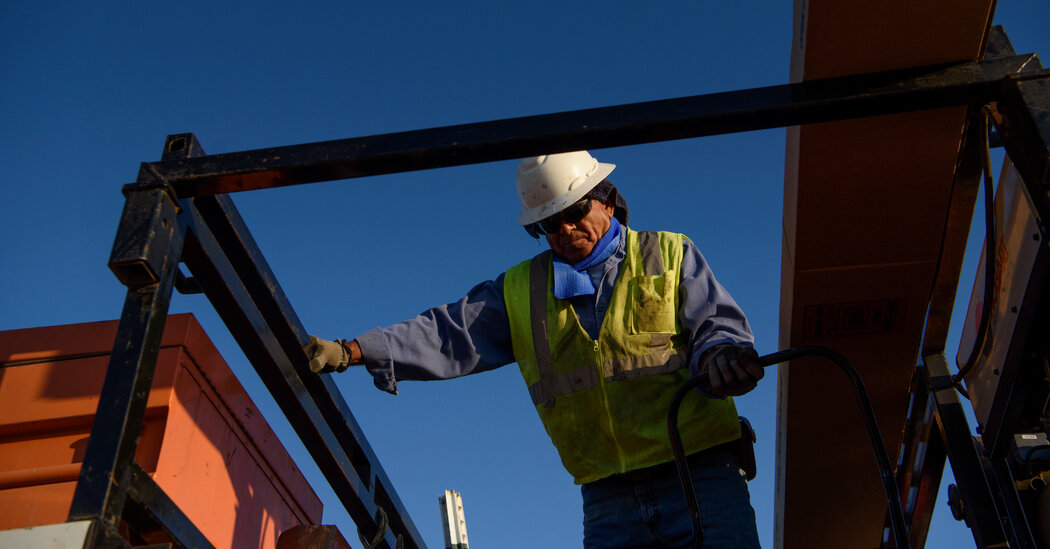A treacherous one-two punch of heat and fire, aggravated by the burning of oil and gas, scorched a large swath of North America on Thursday, killing at least 15 people in the United States in recent days, sickening countless others, closing schools and testing basic services that remain unprepared for the new perils of summer.
Yet it’s only June.
In the United States, a heat dome stretched from Texas to Florida all the way up to the tip of Missouri, ratcheting up the heat index — a combination of temperature and humidity — to above 110 degrees Fahrenheit in some places.
No immediate respite was in sight. Temperatures were projected to climb 15 to 20 degrees above normal in much of the region through the weekend.
And in coming days, a new heat dome was expected to form over California. Sacramento and the San Joaquin Valley, a region where thousands of farm workers labor outdoors for hours, are under excessive heat warnings, the Weather Service said.
Across the breadth of Canada, hundreds of fires continued to burn, drawing 1,500 firefighters from around the globe.
In Toronto, the air quality was, briefly, the worst in the world, as wildfire smoke from other parts of Canada blanketed the city and wafted swiftly southward, shrouding the Eastern United States in toxic soup. In Washington, D.C., the National Gallery closed its outdoor sculpture garden “due to air quality.”
In Nuevo León state, in northern Mexico, schools closed Thursday, about a month earlier than scheduled, after temperatures reached 113 degrees Fahrenheit in Monterrey, the state capital. “To care for children, who are a priority, we decided it wasn’t worth putting their health at risk,” Samuel García Sepúlveda, the governor, said.
Kim Cobb, a climate scientist and director of the Institute at Brown for Environment and Society, said the week’s events embodied the “multiple stressors linked to man-made climate change” that the United Nations has warned about through its scientific panel on global warming. “If ever there was a moment to stop and re-evaluate our fossil fuel emissions trajectory, that moment is now,” she said.
Both extreme heat and wildfires are aggravated by the greenhouse gas emissions that come from the burning of fossil fuels. Those emissions not only make heat waves, which might occur naturally, more extreme but can also intensify the dryness that fuels catastrophic wildfires.
Temperatures around the world in June have reached their highest levels in decades, reflecting two things: Climate change driven by the accumulated emissions of heat-trapping gases and the return, after three years, of the natural climate pattern known as El Niño. Forecasters say that could usher in a multiyear period of extreme heat.
For nearly a half of the United States the forecast for the heat index, a measure of what the temperature actually feels like, fell into the “extreme caution” or “danger” categories. Humid air can keep the body from cooling efficiently because the air is so saturated that moisture from a person’s skin has nowhere to evaporate, a necessity for cooling down.
Adding to the danger, nighttime temperatures are expected to remain high this week in the South and Midwest, making it harder for the human body to have a chance to cool down.
In downtown Jackson, Miss., where the heat index reached to 113 Thursday, workers replacing a wastewater pipe took turns working in the sun for 30-minute stretches at midday, resting under a tree in between. “My advice to anyone is to find some shade,” said Cody Adams, one of the workers with Miller Pipeline, an infrastructure company. “Drink a lot of fluid before you come outside. It’s hot out here.”
Extremely dangerous heat stress is likely to persist through Saturday in Jackson, forecasters said, warning of the risks of heat stroke with prolonged outdoor activity.
In Dallas, where the heat index clocked in at 103, workers were out repairing air-conditioners that had overheated and were blowing out hot air instead of cool. “The compressors are failing left and right,” said Natalie Ortiz, owner of Alpha Heating & Cooling. As of Thursday morning, she had replaced four times as many air-conditioner compressors as she does all summer in a normal year.
“That’s not usual. We just started the summer,” she said.
While some of Texas may finally return to near normal this weekend, portions of Southern Texas and locations near the Gulf of Mexico will continue to experience oppressive temperatures through Sunday.
Heat-related deaths are notoriously hard to accurately account for, because heat can exacerbate pre-existing conditions like kidney and heart disease. Still, early figures were starting to emerge on casualties.
In Webb County, Texas, one of the worst affected parts of the country, the immediate death toll from the heat rose to 10 as of midday Thursday. In Laredo, which is part of Webb County, the heat index was 109 degrees Thursday and expected to rise to 114 Friday.
Mexico has registered at least 112 heat-related deaths so far this year, with more than half of those occurring in Nuevo León state, according to the health ministry. That compares with just four heat-related deaths registered in the same period last year nationwide.
Temperatures in the city of Hermosillo in northwestern Mexico are forecast to hover around 109 degrees through the weekend, after surging to 121 degrees on Sunday, among the highest temperatures registered anywhere in the world that day.
It was the third heat wave of the year in Mexico.
Dan Bilefsky contributed reporting from Montreal; Mary Beth Gahan from Dallas; Jimmie Gates from Jackson, Miss.; Delgar Erdenesanaa, Judson Jones, Anushka Patil, Elena Shao and Raymond Zhong from New York City; and Emiliano Rodriguez Mega and Simon Romero from Mexico City.
Somini Sengupta is The Times’s international climate correspondent. She has also covered the Middle East, West Africa and South Asia and is the author of the book, “The End of Karma: Hope and Fury Among India’s Young.” @SominiSengupta • Facebook
Source: Read Full Article





